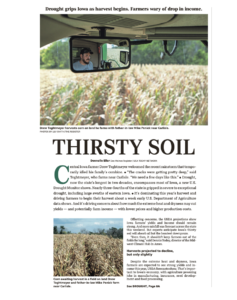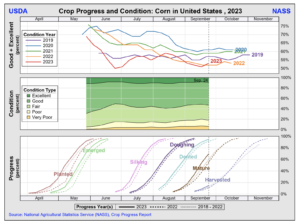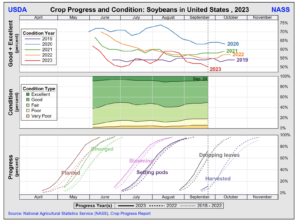Congress has quickly engaged in putting together potential aid packages for farmers that would more than double the Trump administration's $12 billion under the Farmer Bridge Assistance (FBA) Program.
Iowa Drought Concerns Farmers; While 15% of Corn, and 12% of Soybeans Harvested
Donnelle Eller reported on the front page of Sunday’s Des Moines Register that, “Drought, now [Iowa’s] longest in two decades, encompasses most of Iowa, a new U.S. Drought Monitor shows. Nearly three-fourths of the state is gripped in severe to exceptional drought, including large swaths of eastern Iowa.

“It’s dominating this year’s harvest and driving farmers to begin their harvest about a week early, U.S. Department of Agriculture data shows. And it’s driving concern about how much the extreme heat and dryness may cut yields — and potentially farm income ― with lower prices and higher production costs.”
“Offsetting concerns, the USDA projections show Iowa farmers’ yields and income should remain strong.”
Sunday’s article noted that, “Iowa growers are expected to harvest 2.52 billion bushels of corn and 572.5 million bushels of soybeans, both down 2% from last year, the USDA projects. The harvest would mean Iowa continues to be the nation’s largest corn grower and second-largest soybean producer after Illinois.”
30- Day Percent of Normal Precipitation pic.twitter.com/YGrJ9Ouq76
— FarmPolicy (@FarmPolicy) September 25, 2023
Eller explained that, “Farmers will need better-than-expected harvests to compensate for other factors. With higher production costs and lower crop and livestock prices this year, Iowa farmers are expected to see income drop 23%, in line with projections for growers nationally, said Chad Hart, an Iowa State University economist.
“That’s down from a record high last year, according to new, inflation-adjusted USDA data. At $15.9 billion, Iowa’s 2022 farm income outpaced a record $12.8 billion set in 2011, another year when farmers struggled with drought, driving corn and soybean prices to new highs.
Seasonal #Drought Outlook pic.twitter.com/ZgN4pkIGSK
— FarmPolicy (@FarmPolicy) September 25, 2023
“Iowa farm income ‘won’t be a record, but it will still be quite strong,’ Hart said.”
The Register article added that, “The recent rain is a step in the right direction, [Dennis Todey, director of the Midwest Climate Hub in Ames] said, but ‘these are not drought busters. We need multiple rain events throughout the fall‘ to help replenish the soil as well as Iowa’s rivers, streams and groundwater.”
#Illinois Topsoil Moisture, @usda_nass pic.twitter.com/jh7W1CDzuW
— FarmPolicy (@FarmPolicy) September 25, 2023
Meanwhile, DTN Managing Editor Anthony Greder reported yesterday that, “Despite some moderate to heavy rain that fell across the Western Corn Belt this past week, harvest progress for both corn and soybeans maintained a slight lead over the five-year averages nationwide, USDA NASS stated in its weekly Crop Progress report on Monday.”
“Corn harvest picked up speed slightly last week, moving ahead 6 percentage points compared to 4 points the previous week,” the article said; adding that: “NASS said 53% of the corn crop was rated good to excellent as of Sept. 24, up 2 percentage points from 51% last week and up from 52% a year ago.”

Greder pointed out that, “NASS estimated that 12% of the [soybean] crop had been harvested as of Sunday, up 7 points from the previous week.”
“USDA said 50% of the soybean crop was rated good to excellent, down 2 points from 52% the previous week and below 55% a year ago,” yesterday’s article said.

Reuters writer Tom Polansek reported yesterday that, “Traders are digesting yield reports from harvested fields, with farmers expected to bring in the second largest corn crop on record.”
And Dow Jones writer Kirk Maltais reported yesterday that, “Inspections of soybeans and wheat exports are higher than reported last week, according to the latest weekly report from the Department of Agriculture.
“In its latest Grain Export Inspections report, the USDA said that soybean inspections totaled 481,638 metric tons for the week ended September 21, which is up from 429,772 tons reported in the previous week. Wheat inspections totaled 451,004 tons, up from 422,639 tons.
“Corn inspections, meanwhile, were slightly down from the previous week. Inspections were reported at 660,811 tons through September 21, which is slightly off from 676,323 tons previously.”
The article indicated that, “Total corn and soybean inspections are up from the previous year, the USDA reports – with corn inspections up nearly 16% from this time last year and soybean inspections up 6.5%. Wheat inspections are slightly down from last year, falling just over 28%.”





